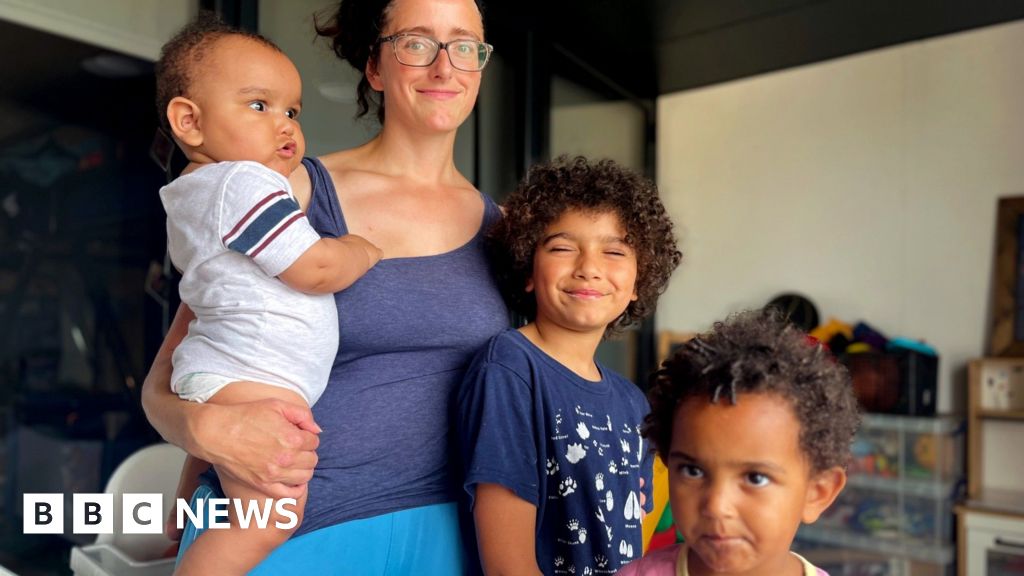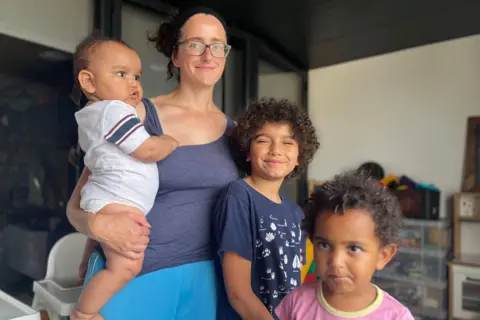 BBC
BBCThea and Kirsty each have three kids, however contrasting insurance policies on advantages in England and Scotland imply their lives are very completely different. After a Commons row about scrapping the two-child profit cap, we meet the households affected.
In a one-bed flat in north London, Thea Jaffe is struggling to get her 10-month-old son Isaac to remain quiet.
Isaac is the primary motive we’re right here. He’s Thea’s third little one, and as she depends on advantages to prime up her wage, she doesn’t get Common Credit score or Baby Tax Credit for him as a result of two-child coverage.
Launched by the Conservatives, the coverage means any third or subsequent little one born to a household after April 2017 doesn’t get totally supported by the advantages system, solely receiving the £16.95 every week little one profit cost.
Thea, a 38-year-old account improvement supervisor for a logistics firm, knew that cash could be tight when she unexpectedly grew to become pregnant. She knew concerning the coverage and did think about alternate options. However in the end she determined to have Isaac.
“I could not make this resolution based mostly on a authorities coverage, as a result of that might change in a heartbeat,” she says. “All it takes is one election and the setting is completely completely different. Do you actually wish to make choices about your loved ones based mostly on one thing that is so changeable?”
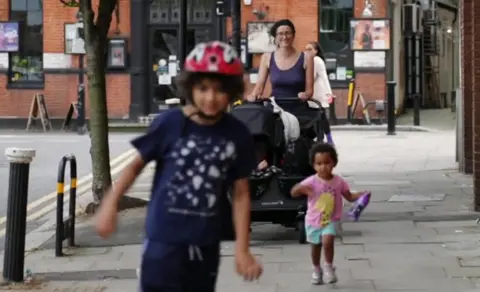
Over the course of the subsequent hour or so, her different two kids wander out and in. 9-year-old Moses completed college earlier this week and wishes some power burning off; JJ, who is 2, groggily walks into the lounge following a nap.
Their lease has elevated by £800 a month up to now two years, says Thea, as they needed to transfer. The 2-child coverage means bigger households miss out on round £3500 a 12 months per little one, and Thea’s £43,000 wage isn’t practically sufficient to banish issues about cash.
A change of coverage, as many MPs need, would imply “we might be capable to purchase milk on the best way dwelling as an alternative of taking a detour to seek out the most affordable milk. We might be capable to loosen up a bit of bit in our meal planning. And in flip, that [would] give me extra head house to essentially assist them with their homework and be there for them emotionally and simply mum or dad them the best way I wish to mum or dad them.”
Thea Jaffe’s predicament goes to the center of the issue the brand new authorities is going through on this challenge.
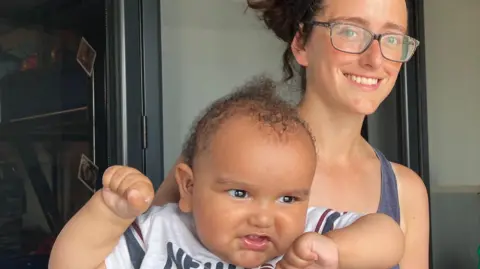
The overt goal of the coverage was “to make sure that households in receipt of advantages confronted the identical monetary decisions about having kids as these supporting themselves solely in work,” in response to then Chancellor George Osborne. The coverage, ministers mentioned on the time, would additionally encourage them to work extra.
The coverage does appear standard – a YouGov ballot from final 12 months advised that 60% of the general public supported maintaining it.
Analysis nonetheless signifies that it hasn’t succeeded in attaining its objectives. A paper from 2022 advised that the coverage had lowered the likelihood of an affected household having a 3rd or subsequent little one by simply 5%. A report from the Home of Commons Work and Pensions Choose Committee concluded there was no proof it elevated employment amongst bigger households.
In the meantime, official authorities knowledge exhibits it has elevated little one poverty amongst bigger households, from 41% in 2016/17 to 46% within the newest figures.
The 2-child coverage impacts 440,000 households, with 1.6m kids between them. It impacts households throughout the UK, however the affect of the coverage has been considerably lowered in Scotland as a result of Scottish Baby Fee.
Launched by the Scottish authorities in 2021, it has since been prolonged and the worth of the cost elevated – it’s now value £26.70 every week and is payable for every little one below 16 dwelling in a low earnings family. Its presently obtained by 330,000 kids. “It alleviates among the strain that you’ve got from month to month,” says Kirsty Murray, a mom of three from Cumbernauld.
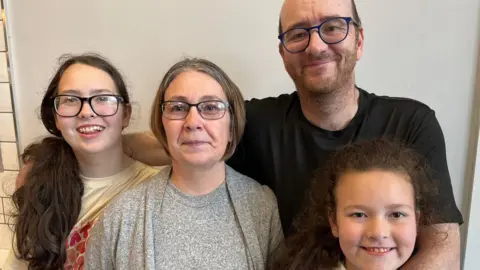
The 43-year-old works for a charity whereas her husband, Dougie, is a private help employee for folks with disabilities. Two of their three kids – 16-year-old David and Rebekah, 12 – have extra wants, so the household’s whole earnings of £25,000 is commonly stretched.
Subsequent time period they will even have to start out paying for college meals for his or her youngest daughter, Mia, who’s 10. The Scottish Baby Fee pays the household £213.60 each 4 weeks for his or her two daughters; David’s cost stopped when he turned 16.
“Life is tense if you’ve two youngsters with extra wants,” says Kirsty. “It means we will do issues like exit for a meal, go to the photographs, do no matter it’s the youngsters wish to do.”
She’s totally conscious that she’s extra lucky than related dad and mom in England. “Is that truthful? No. If the governments labored collectively and mentioned, ‘Okay, what works in Scotland?’ Why cannot one thing related be finished in England.”
The Scottish Baby Fee has broad cross-party political help. It price £430m within the final monetary 12 months, paid for by larger tax charges in Scotland. Early proof suggests it has barely lowered the necessity for sure households to make use of foodbanks.
The Scottish authorities estimates that it’ll hold 60,000 kids out of poverty this 12 months, however little one poverty ranges in Scotland haven’t fallen for the reason that coverage was launched.
“We all know that inflation was very excessive for a number of years and so prices had been rising and households had been going through lots of strain on their incomes,” says Hannah Randolph, an economist at Strathclyde College’s Fraser of Allander Institute. “So it’s attainable the speed of kid poverty would have been larger within the absence of the Scottish Baby Fee.”
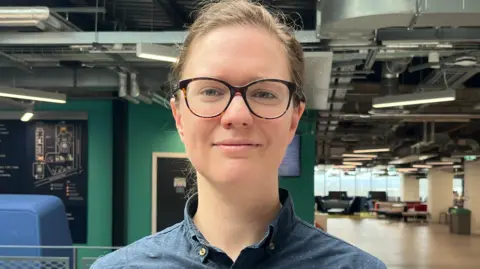
The Kids’s Commissioner for Wales has referred to as for the Welsh authorities to repeat the Scottish Baby Fee however there was no related suggestion from the brand new Labour authorities.
It insists that it could possibly’t presently afford to scrap the 2 little one restrict, which might price over £3bn. The prime minister says that tackling little one poverty requires a rounded technique that doesn’t simply give attention to one coverage.
There may be “no silver bullet” to coping with the issue, Sir Keir Starmer advised the Commons earlier this week. “It’s an advanced set of things – to do with work, to do with housing, to do with schooling, to do with well being. That’s why you want a method to cope with it.”
The final Labour authorities did lower little one poverty. A authorities report in 2012 confirmed that the variety of kids dwelling in relative poverty had decreased by 1.1m between 1998/99 and 2010/11, falling from 26% of kids to 18%.
The Institute for Fiscal Research assume tank discovered {that a} key aspect in that change was an £18bn annual improve in spending on advantages for households with kids.
In accordance with Ruth Patrick, a professor of social coverage at York College, reforming the welfare system is in the end the important thing to tackling the issue.
“We do want to have a look at housing, work, childcare, early years and schooling. However the basic reply, pushed by the proof, is that we will’t handle little one poverty with out investing in our social safety system. It’s that easy.”

